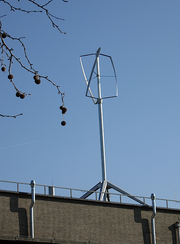
Turby wind turbine
Encyclopedia

Darrieus wind turbine
The Darrieus wind turbine is a type of vertical axis wind turbine used to generate electricity from the energy carried in the wind. The turbine consists of a number of aerofoils usually—but not always—vertically mounted on a rotating shaft or framework...
. The three vertical aerofoil blades have a helical twist of 60 degrees, similar to Gorlov's water turbines
Gorlov helical turbine
The Gorlov helical turbine is a water turbine evolved from the Darrieus turbine design by altering it to have helical blades/foils. It was patented in a series of patents from September 19, 1995 to July 3, 2001 and won 2001 ASME Thomas A. Edison . GHT was invented by Professor Alexander M...
.
The turbine consists of three vertical symmetrical airfoil
Airfoil
An airfoil or aerofoil is the shape of a wing or blade or sail as seen in cross-section....
blades, each having a helical
Helix
A helix is a type of smooth space curve, i.e. a curve in three-dimensional space. It has the property that the tangent line at any point makes a constant angle with a fixed line called the axis. Examples of helixes are coil springs and the handrails of spiral staircases. A "filled-in" helix – for...
twist. The helical feature spreads the torque
Torque
Torque, moment or moment of force , is the tendency of a force to rotate an object about an axis, fulcrum, or pivot. Just as a force is a push or a pull, a torque can be thought of as a twist....
evenly over the entire revolution, thus preventing the destructive pulsations of the straight-bladed giromill (Darrieus turbine). The wind pushes each blade around on both the windward and leeward sides of the turbine. As with a Darrieus turbine, theoretically, there is no torque on a stationary turbine, due to symmetry of the turbine and of the blades. Starting is achieved by operating the generator as a motor. Torque is caused by a change in the apparent wind direction relative to the moving blades.
Another advantage of the helical twist is that the blades generate torque well from upward-slanting airflow. This is negligible in open country, but tall buildings and cliff faces generate a bow wave which directs airflow up and over them. Turbines mounted on high building rooftops or clifftops are exposed to significantly slanting flow, and the Turby can extract more useful energy from it than a propeller-type turbine can because HAWT
HAWT
HAWT may refer to:* Health and welfare trust* Horizontal-axis wind turbine* Slang for Physical attractiveness or Sexual arousal...
types need time to adjust their yaw to face the wind direction.
The turbine measures 2.0m (6'7") in diameter by 2.9m (9'6") high (including generator), and weighs 136 kg (300 lb). It is specified to generate power in winds of between 4m/s (9 mph, 7.8kts) and 14m/s (31 mph, 27.2kts), and can survive winds of 55m/s (123 mph, 107kts). The rated power at 14m/s is 2.5 kW (3.35 hp). The AC output from the synchronous generator is rectified to DC, then inverted to AC at 230V 50Hz.
Core International developed the turbine in the Netherlands
Netherlands
The Netherlands is a constituent country of the Kingdom of the Netherlands, located mainly in North-West Europe and with several islands in the Caribbean. Mainland Netherlands borders the North Sea to the north and west, Belgium to the south, and Germany to the east, and shares maritime borders...
with research input from the Delft University of Technology
Delft University of Technology
Delft University of Technology , also known as TU Delft, is the largest and oldest Dutch public technical university, located in Delft, Netherlands...
.
See also
- List of wind turbine manufacturers
- Distributed generationDistributed generationDistributed generation, also called on-site generation, dispersed generation, embedded generation, decentralized generation, decentralized energy or distributed energy, generates electricity from many small energy sources....
- Net meteringNet meteringNet metering is an electricity policy for consumers who own renewable energy facilities or V2G electric vehicles. "Net", in this context, is used in the sense of meaning "what remains after deductions" — in this case, the deduction of any energy outflows from metered energy inflows...
- Betz' lawBetz' lawBetz's law is a theory about the maximum possible energy to be derived from a "hydraulic wind engine", or a wind turbine such as the Éolienne Bollée , the Eclipse Windmill , and the Aermotor...
External references
- Turby b.v.
- A quiet revolution - wind energy for town and country - Story about Turby
- Turby >35%

